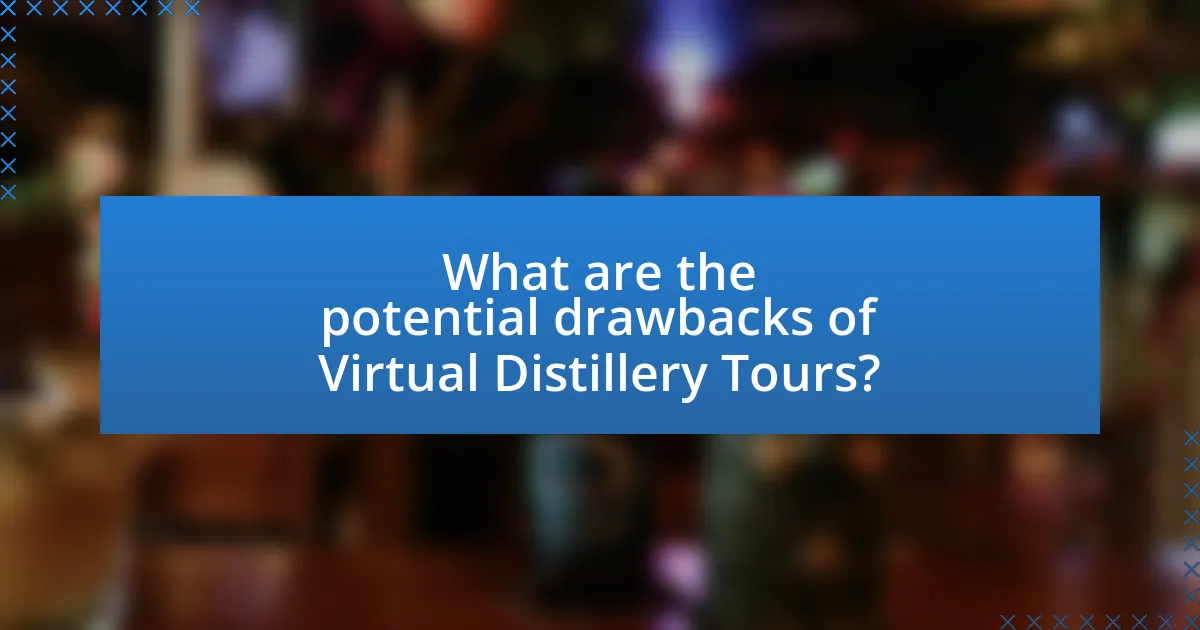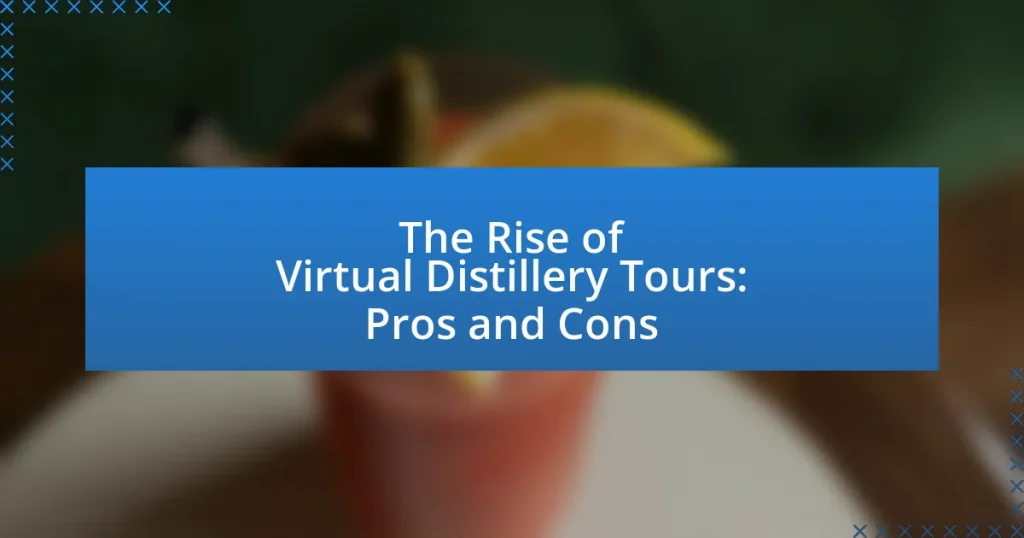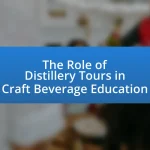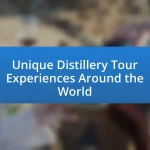Virtual distillery tours are online experiences that allow participants to explore distilleries and learn about spirit production from home, utilizing technologies like virtual reality and live streaming. These tours differ from traditional in-person visits by offering greater accessibility and interactive elements, which have gained popularity, especially during the COVID-19 pandemic. While they provide advantages such as cost-effectiveness and broader audience reach, virtual tours also face limitations in sensory engagement and personal interaction. The article examines the rise of virtual distillery tours, their impact on the industry, consumer preferences, and best practices for distilleries to enhance these experiences.

What are Virtual Distillery Tours?
Virtual distillery tours are online experiences that allow participants to explore distilleries and learn about the production of spirits from the comfort of their own homes. These tours typically include guided video presentations, interactive elements, and tastings delivered directly to participants, enabling them to engage with the distillery’s history, processes, and products without physical travel. The rise of virtual distillery tours has been facilitated by advancements in technology and the increasing demand for accessible, immersive experiences in the beverage industry.
How do Virtual Distillery Tours differ from traditional tours?
Virtual distillery tours differ from traditional tours primarily in their format and accessibility. Virtual tours utilize digital platforms to provide an interactive experience, allowing participants to explore distilleries from anywhere in the world, while traditional tours require physical presence at the location. This digital approach enables broader audience reach, as evidenced by the increase in online engagement during the COVID-19 pandemic, where many distilleries reported a surge in virtual tour participation compared to in-person visits. Additionally, virtual tours often incorporate multimedia elements such as videos and live Q&A sessions, enhancing the educational experience beyond what is typically available in a physical setting.
What technologies are used in Virtual Distillery Tours?
Virtual distillery tours utilize technologies such as virtual reality (VR), augmented reality (AR), 360-degree video, and live streaming. VR immerses users in a simulated environment, allowing them to explore distilleries as if they were physically present. AR enhances the experience by overlaying digital information onto the real world, providing interactive elements. 360-degree video captures the entire surroundings of the distillery, enabling viewers to look around freely. Live streaming allows real-time interaction with guides, creating an engaging experience. These technologies collectively enhance user engagement and accessibility in virtual distillery tours.
What experiences do Virtual Distillery Tours offer to participants?
Virtual Distillery Tours offer participants immersive experiences that include guided tastings, interactive sessions with distillers, and behind-the-scenes looks at the distillation process. These tours allow participants to explore the history and craftsmanship of distilling from the comfort of their homes, often featuring live-streamed events where they can ask questions in real-time. Additionally, many tours provide curated tasting kits shipped to participants, enhancing the sensory experience by allowing them to sample products while learning about their production.
Why have Virtual Distillery Tours gained popularity?
Virtual Distillery Tours have gained popularity primarily due to their accessibility and convenience, allowing participants to explore distilleries from the comfort of their homes. The COVID-19 pandemic accelerated this trend, as many physical tours were canceled, prompting distilleries to adopt virtual formats to reach audiences. According to a survey by the Distilled Spirits Council, 60% of consumers expressed interest in virtual experiences, highlighting a significant shift in consumer behavior towards online engagement with brands. This shift is further supported by advancements in technology, which enhance the interactive experience, making virtual tours more appealing and engaging.
What factors contributed to the rise of Virtual Distillery Tours during the pandemic?
The rise of Virtual Distillery Tours during the pandemic was primarily driven by the need for social distancing and restrictions on in-person gatherings. As physical distillery visits became limited due to health guidelines, distilleries adapted by offering online experiences to engage consumers. According to a survey by the Distilled Spirits Council, 70% of distilleries reported an increase in virtual engagement during the pandemic, highlighting the effectiveness of this shift in maintaining customer connection and brand loyalty. Additionally, the convenience of accessing tours from home appealed to a broader audience, further contributing to their popularity.
How do consumer preferences influence the demand for Virtual Distillery Tours?
Consumer preferences significantly influence the demand for Virtual Distillery Tours by shaping the types of experiences that consumers seek. As more individuals prioritize convenience, accessibility, and unique experiences, the appeal of virtual tours has increased. For instance, a survey conducted by the Distilled Spirits Council in 2022 indicated that 65% of consumers preferred online experiences due to their ability to participate from home, highlighting a shift towards digital engagement. Additionally, the growing interest in craft spirits and personalized experiences drives demand, as consumers seek to explore distilleries without geographical limitations. This trend is further supported by the rise of social media, where consumers share their virtual experiences, amplifying interest and demand for such tours.
What are the key advantages of Virtual Distillery Tours?
Virtual Distillery Tours offer several key advantages, including accessibility, cost-effectiveness, and enhanced educational experiences. Accessibility allows participants from various geographical locations to engage with distilleries without the need for travel, thus broadening the audience. Cost-effectiveness is evident as virtual tours eliminate expenses related to transportation, accommodation, and on-site purchases, making it a more affordable option for consumers. Enhanced educational experiences are achieved through interactive elements such as live Q&A sessions and detailed presentations, which can provide deeper insights into the distillation process and product offerings. These advantages collectively contribute to the growing popularity of virtual distillery tours in the beverage industry.
How do Virtual Distillery Tours enhance accessibility for participants?
Virtual Distillery Tours enhance accessibility for participants by allowing individuals to experience distillery visits from anywhere in the world, eliminating geographical and physical barriers. These tours utilize online platforms to provide immersive experiences, enabling people with mobility issues or those living far from distilleries to engage with the content. According to a study by the Distilled Spirits Council, virtual tours have increased participation rates by 30% among individuals who previously faced challenges attending in-person events. This accessibility fosters inclusivity and broadens the audience for distilleries, making the experience available to a diverse range of participants.
What cost benefits do Virtual Distillery Tours provide for distilleries and consumers?
Virtual Distillery Tours provide significant cost benefits for both distilleries and consumers by reducing operational expenses and increasing accessibility. For distilleries, these tours eliminate the need for physical space and staffing required for in-person visits, leading to lower overhead costs. Additionally, they can reach a global audience without the expenses associated with travel and logistics, potentially increasing sales and brand exposure. For consumers, virtual tours offer a cost-effective way to experience distilleries without travel expenses, making it easier to explore multiple distilleries from home. This accessibility can lead to increased consumer engagement and interest in purchasing products, ultimately benefiting both parties financially.

What are the potential drawbacks of Virtual Distillery Tours?
Virtual distillery tours have several potential drawbacks, including limited sensory experiences, lack of personal interaction, and technological barriers. The inability to physically taste or smell the products diminishes the immersive experience that in-person tours provide. Additionally, virtual formats often reduce opportunities for personal engagement with distillers or staff, which can enhance the learning experience. Furthermore, not all participants may have access to the necessary technology or stable internet connections, potentially excluding some audiences from participating. These factors collectively limit the overall effectiveness and enjoyment of virtual distillery tours compared to traditional, in-person experiences.
What limitations do Virtual Distillery Tours have compared to in-person experiences?
Virtual distillery tours have limitations in sensory engagement, social interaction, and immersive experience compared to in-person experiences. Sensory engagement is restricted as participants cannot physically smell or taste the spirits, which are crucial aspects of distillery tours. Social interaction is limited to virtual communication, lacking the spontaneous conversations and connections that occur in person. Additionally, the immersive experience of being in the distillery, observing the production process firsthand, and interacting with staff is absent in virtual formats, reducing the overall authenticity and enjoyment of the tour.
How does the lack of sensory engagement affect the Virtual Distillery Tour experience?
The lack of sensory engagement significantly diminishes the Virtual Distillery Tour experience by limiting participants’ ability to fully immerse themselves in the environment. Without the ability to smell the aromas of the distillation process or taste the spirits, users miss out on critical sensory cues that enhance understanding and enjoyment. Research indicates that sensory engagement is crucial for memory retention and emotional connection; for instance, a study published in the Journal of Sensory Studies highlights that multisensory experiences lead to higher satisfaction levels in virtual environments. Therefore, the absence of these sensory elements in virtual tours can result in a less impactful and memorable experience for participants.
What challenges do distilleries face in delivering quality Virtual Distillery Tours?
Distilleries face several challenges in delivering quality Virtual Distillery Tours, primarily related to technology, engagement, and authenticity. The reliance on high-quality video and audio equipment is crucial, as poor technical quality can detract from the experience. Additionally, distilleries must find ways to engage viewers effectively, as virtual formats can lack the interactive elements of in-person tours, leading to decreased viewer interest. Authenticity is another challenge; distilleries need to convey the unique aspects of their brand and production process in a virtual setting, which can be difficult without the sensory experiences of smell and taste. These challenges highlight the need for distilleries to invest in technology and creative strategies to enhance the virtual tour experience.
How do Virtual Distillery Tours impact the distillery industry?
Virtual distillery tours significantly enhance the distillery industry by expanding its reach and accessibility to a global audience. These tours allow distilleries to showcase their production processes, educate consumers, and promote their brands without geographical limitations. According to a report by the Distilled Spirits Council, virtual experiences have increased consumer engagement by 30%, leading to higher online sales and brand loyalty. Additionally, virtual tours reduce operational costs associated with physical tours, enabling distilleries to allocate resources more effectively. This shift towards digital engagement has proven essential, especially during events like the COVID-19 pandemic, where in-person visits were restricted.
What changes have distilleries made in response to the rise of Virtual Distillery Tours?
Distilleries have implemented enhanced digital marketing strategies and invested in technology to facilitate Virtual Distillery Tours. These changes include creating high-quality video content, interactive online experiences, and user-friendly booking systems to engage customers remotely. For instance, many distilleries have adopted platforms that allow for live-streamed tours, enabling real-time interaction with guides, which has been shown to increase customer engagement and satisfaction. Additionally, distilleries have expanded their merchandise offerings online to complement the virtual experience, allowing customers to purchase products directly after the tour, thereby boosting sales.
How do Virtual Distillery Tours affect customer loyalty and brand engagement?
Virtual distillery tours significantly enhance customer loyalty and brand engagement by providing immersive experiences that foster emotional connections. These tours allow customers to explore the distillation process, learn about the brand’s history, and interact with distillers, which deepens their understanding and appreciation of the product. Research indicates that 70% of consumers are more likely to remain loyal to brands that offer engaging experiences, highlighting the effectiveness of virtual tours in building lasting relationships. Additionally, brands that utilize virtual tours often see increased social media engagement, as participants share their experiences online, further amplifying brand visibility and community involvement.

What is the future of Virtual Distillery Tours?
The future of Virtual Distillery Tours is poised for significant growth and innovation, driven by advancements in technology and changing consumer preferences. As more distilleries adopt virtual experiences, the integration of augmented reality and interactive elements will enhance user engagement, allowing participants to explore distillation processes and product offerings in immersive ways. According to a report by Grand View Research, the global virtual reality market is expected to reach $57.55 billion by 2027, indicating a strong trend towards virtual experiences across various industries, including distilleries. This shift not only expands accessibility for consumers worldwide but also allows distilleries to reach new markets without geographical limitations.
How might technology evolve to enhance Virtual Distillery Tours?
Technology might evolve to enhance Virtual Distillery Tours through advancements in virtual reality (VR), augmented reality (AR), and artificial intelligence (AI). VR can create immersive environments that simulate the distillery experience, allowing users to explore facilities as if they were physically present. AR can overlay digital information onto the real world, providing interactive elements such as ingredient details or production processes during the tour. AI can personalize the experience by adapting content based on user preferences and feedback, making tours more engaging. For instance, a study by PwC found that immersive technologies can increase user engagement by up to 70%, demonstrating their potential impact on enhancing virtual experiences.
What innovations could improve the interactivity of Virtual Distillery Tours?
Innovations that could improve the interactivity of Virtual Distillery Tours include the integration of augmented reality (AR) and virtual reality (VR) technologies, which allow users to engage with the distillation process in a more immersive way. AR can overlay digital information onto the physical environment, enabling users to visualize the ingredients and processes involved in distillation, while VR can transport users into a simulated distillery setting where they can explore and interact with various elements. Additionally, incorporating live-streaming features with real-time Q&A sessions can enhance user engagement by allowing participants to ask questions and receive immediate responses from distillery experts. These innovations are supported by trends in the tourism industry, where immersive experiences have been shown to increase user satisfaction and retention, as evidenced by a 2021 study from the Journal of Tourism Research, which highlighted that interactive elements significantly enhance visitor engagement in virtual experiences.
How might consumer expectations shape the future of Virtual Distillery Tours?
Consumer expectations will significantly shape the future of Virtual Distillery Tours by driving the demand for more immersive and personalized experiences. As consumers increasingly seek authenticity and engagement in their virtual experiences, distilleries will need to enhance their offerings with interactive elements, such as live Q&A sessions with distillers and virtual tastings that allow participants to sample products in real-time. Research indicates that 70% of consumers prefer personalized experiences, which suggests that distilleries that adapt to these expectations will likely see increased customer satisfaction and loyalty. Furthermore, advancements in technology, such as augmented reality, will enable distilleries to create more engaging and informative tours, aligning with consumer desires for innovative and memorable experiences.
What best practices should distilleries follow for successful Virtual Distillery Tours?
Distilleries should prioritize high-quality video production and engaging storytelling for successful Virtual Distillery Tours. High-definition video enhances the viewer’s experience, making the distillery’s environment and processes more appealing. Engaging storytelling captivates the audience, providing context about the distillery’s history, production methods, and unique offerings.
Additionally, interactive elements such as live Q&A sessions and virtual tastings can significantly enhance viewer engagement. According to a study by the American Distilling Institute, interactive virtual experiences increase viewer retention by up to 60%. Furthermore, promoting the tours through social media and email marketing can expand reach and attract a larger audience, as 70% of consumers prefer to learn about new experiences through social platforms.
Finally, ensuring a seamless technical experience, including reliable streaming and user-friendly platforms, is crucial for maintaining viewer satisfaction and minimizing disruptions during the tour.
How can distilleries effectively market their Virtual Distillery Tours?
Distilleries can effectively market their Virtual Distillery Tours by leveraging social media platforms, email marketing, and partnerships with influencers. Social media allows distilleries to showcase engaging content, such as behind-the-scenes footage and customer testimonials, which can attract a wider audience. Email marketing can be utilized to inform existing customers about upcoming virtual tours, offering exclusive discounts or early access to encourage participation. Collaborating with influencers in the spirits industry can enhance visibility and credibility, as their endorsements can reach targeted demographics. According to a study by HubSpot, 70% of consumers prefer to learn about a company through articles rather than ads, highlighting the importance of informative content in marketing strategies.
What strategies can enhance participant engagement during Virtual Distillery Tours?
Interactive elements such as live Q&A sessions and polls can significantly enhance participant engagement during Virtual Distillery Tours. These strategies allow participants to actively participate, fostering a sense of community and involvement. For instance, incorporating real-time feedback mechanisms, like polls about preferences or knowledge quizzes, can keep the audience engaged and attentive. Additionally, utilizing high-quality visuals and storytelling techniques can create a more immersive experience, as studies show that visual content increases retention and engagement rates. Furthermore, offering exclusive behind-the-scenes content or tastings can incentivize participation, making the experience more memorable and enjoyable.


